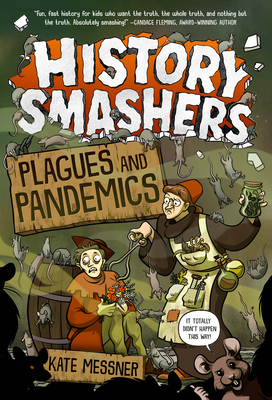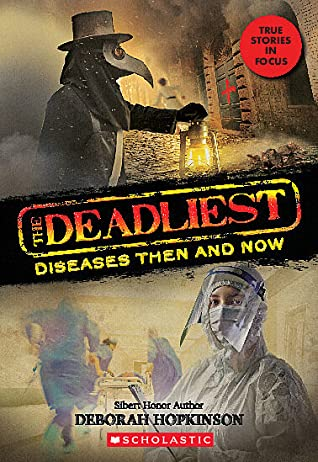WILD & (sometimes not so) WONDERFUL WEDNESDAY: Three middle grade nonfiction books about disease, pandemics, and vaccines!
With the arrival of COVID, having some knowledge and understanding of disease, pandemics, and vaccines is very important. These three books are all thoroughly documented and present information is a solid, understandable way that works well for the intended audience (as well as an older audience, I learned quite a bit). Each book works particularly well in certain ways. A Shot in the Arm is a graphic history of the development of vaccines and why they are necessary and helpful. The Deadliest Diseases Then and Now focuses mostly on the plague and a bit on the Spanish Flu epidemic of 1918, and concludes with a brief chapter on COVID-19. Hopkinson focuses a great deal on how disease spreads and how scientists developed their knowledge that slowly led to the development of vaccines. Kate Messner's Plagues and Pandemics looks more broadly at a variety of diseases and the damage that have done and continue to do in some cases and how scientists over time learned from their predecessors in developing treatments and vaccines. She also specifically addresses some of the lies and myths that seem to crop up whenever a pandemic occurs. Together these three books provide a nice introduction to the world of dangerous microbes and the fight still being waged against them. Note: because of the topic, there are some gruesome details included the authors talk about symptoms and the consequences of disease.
ABOUT THE BOOK
Myths! Lies! Secrets! Uncover the hidden truth about history's pandemics, from the Black Death to COVID-19. Perfect for fans of I Survived! and Nathan Hale's Hazardous Tales.
During the Black Death in the 14th century, plague doctors wore creepy beaked masks filled with herbs. RIGHT?
WRONG! Those masks were from a plague outbreak centuries later--and most doctors never wore anything like that at all!
With a mix of sidebars, illustrations, photos, and graphic panels, acclaimed author Kate Messner delivers the whole truth about diseases like the bubonic plague, cholera, smallpox, tuberculosis, polio, influenza, and COVID-19.
Discover the nonfiction series that smashes everything you thought you knew about history! Don't miss History Smashers: The Mayflower, Women's Right to Vote, Pearl Harbor, Titanic, and American Revolution.
REVIEW
As with her other History Smasher titles, Messner presents middle grade readers with a solid introduction to disease and the wide variety of beliefs about their causes and treatments. Her focus is on addressing some of the many lies and myths that have been accepted as truth at various times and places in human history. Using sidebars, cartoon-like illustrations, photographs, and comics, Messner and Koch share with readers a fascinating introduction to the world of pandemics and vaccines. She shares information about a variety of different diseases and how the world has adapted to them. I especially enjoyed her brief introduction to some of the many 'health care heroes' who have helped to fight disease over the centuries. The book is very readable which for a challenging topic like this is very important, Messner makes a difficult topic understandable for the intended audience. The back matter is through and makes it clear that Messner worked hard to get things right. I loved the fact that she doesn't hold back, she presents things as they are and clearly points out the harm and various lies and myths have caused over the years, including misplaced blame. The nature of the topic guarantees that things get a bit gruesome at times. But for young readers interested in the topic this is a fabulous and important book.
ABOUT THE BOOK
Perfect for young readers of I Survived and the Who Was series! Packed with graphics, photos, and facts for curious minds, this is a gripping look at pandemics through the ages.
The deadly outbreak of plague known as the Great Mortality, which struck Europe in the mid 1300s and raged for four centuries, wiped out more than 25 million people in the course of just two years. With its vicious onslaught, life changed for millions of people almost instantaneously.
Deadly pandemics have always been a part of life, from the Great Mortality of the Middle Ages, to the Spanish Influenza outbreak of 1918, to the eruption of COVID-19 in our own century. Many of these diseases might have seemed like things to read about in history books -- until the unthinkable happened, and our own lives were turned upside down by the emergence of the novel coronavirus.
As we learn more about COVID-19, we may be curious about pandemics of the past. Knowing how humans fought diseases long ago may help us face those of today. In this fast-paced, wide-ranging story filled with facts, pictures, and diagrams about diseases -- from plague to smallpox to polio to flu -- critically acclaimed Sibert Honor author Deborah Hopkinson brings voices from the past to life in this exploration of the deadliest diseases of then and now. Filled with more than 50 period photographs and illustrations, charts, facts, and pull-out boxes for eager nonfiction readers.
REVIEW
Deborah Hopkinson's The Deadliest series introduces middle grade readers to various disasters that the world has seen and continues to experience. In this particular title, readers are introduced to the challenges related to pandemics. It's a fascinating look into how diseases move and plague the world, both human and animal. Scientists who've helped discover the source and causes of some diseases are discussed along with a few of the influential people who helped in the development of vaccines. The first half of the book looks at bubonic and other forms of plague and the incredible devastation that it caused. Hopkinson tracks the spread of the disease as well as the work that went into finding a treatment and vaccine. I appreciated her acknowledgement that there is still much to learn about the disease. The influenza outbreak of 1918 comes next, followed by a chapter on other troublesome diseases such as cholera, polio, and tuberculosis. Included throughout the book are numerous photographs as well as sidebars about medicine and how scientists have gained knowledge over the years. The back matter includes not only a glossary and index, but a selected bibliography and suggested reading. Also included are some post reading activities and a note to readers about the value of primary source material and how they can contribute to history. I found this book fascinating and informative with enough detail to give young readers a look into the realities of the past without being too graphic and gory. But the fact is this topic is by its very nature sometimes gross and disgusting. For young readers interested in the subject matter, this is a great book on the subject.
ABOUT THE BOOK
A graphic novel exploration of the history of vaccinations and the fight to protect people from diseases.
REVIEW
With diseases continuing to ravage the world on a daily basis it's useful to have a working knowledge of the science behind vaccines. Told in a comic book format, Brown presents readers with an introduction to vaccines and some of the events and people who helped in their development. Basic information about bacteria, viruses, and the human immune system's reaction to them is shared in order to help readers understand how vaccines work. The author doesn't shy away from some of the awful things that have occurred related to disease such as blaming certain races or ethnicities for the spread of disease. Nor does he shy away from pointing out some of the problems that have occurred during the development of certain vaccines. Being a work for young readers, and in a graphic format, the book doesn't cover everything related to vaccines, but it provides a good basic introduction to the value of vaccines and how they come to pass. The book was publishing during the COVID-19 pandemic and so does introduce the topic, but doesn't include all the latest information. Because of the nature of the topic (disease) there are some gross and disgusting parts, but to me it doesn't get too graphic, but it will depend on the reader. This is another fine work that is well researched and includes a solid amount of back matter including a time line, bibliography and author's note.






Comments
Post a Comment